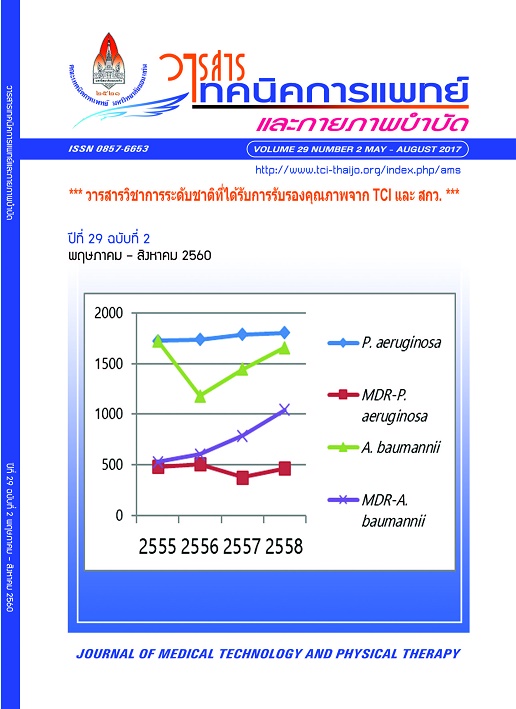Efficiency of AnyplexTMII MTB/MDR detectionfor identification of multidrug resistant Mycobacterium tuberculosis compared with drug proportional method
Main Article Content
Abstract
Multi-drug resistant of Mycobacterium tuberculosis(MDR-TB) causes the life-threatening pulmonary disease worldwide including Thailand. It resists at least 2 drugs including rifampicin and isoniazid, which are the first-line anti-tuberculous drug of choice. Diagnosis of MDR-TB has generally based on cultivation and anti-tuberculous agent by proportional method and liquid medium that takes at least 2 months to report. Recently, AnyplexTMII MTB/MDR Detection system cooperated with real-time PCR were launched for molecular diagnosis of MDR-TB at 10th Office of Disease Prevention and Control, Ubon Ratchathani. The system is able to identify 18 and 7 mutations associated rifampicin (RIF)and isoniazid resistance, respectively. In order to evaluate efficiency of the Anyplex II system, 105 clinical MDR-TB of unrepeated patients from Ubon Ratchathani, Si Sa Ket, Sakon Nakhon, Nakhon Phanom, Amnat Charoen, Mukdahan,and Yasothon isolated were collected during October 2009-September 2012 and stored in at -20°C skimmed milk were enrolled to conducted against the proportional test and Anyplex II system. Ninety-nine isolates (94.3%) were verified as MDR-TB isolates, but the others were identified as INH-resistant (3, 2.9%) and susceptible (3, 2.9%) isolates, respectively. Of 99 MDR-TB, Anyplex II system could identify 88 isolates (88.9%). Inter-rater agreement analysis between the proportional test and Anyplex II system for detection of INH and RIF resistance revealed moderate agreements for detection of INH (Cohen’s kappa = 0.402) and good agreement for RIF resistance (Cohen’s kappa=0.731), respectively. It implied that the 11.1% of undetectable MDR-TB by Anyplex II system may be associated with the efficiency of INH detection for the MDR-TB strains. In conclusion, Anyplex II MTB/MDR Detection system may be an available molecular tool fordetection of MDR-TB in Northeastern of Thailand. However, the sequencing of hotspot regions associated with INH and RIF should be further studied in order to evaluate discordant results of these two techniques.


